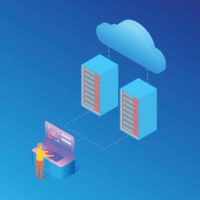We know that customer expectations are increasing, and they are choosing brands that care and invest in sustainability. A good service offering is no longer enough on its own to influence today’s consumers, they want more — they want a brand they identify with in terms of values around sustainability.
A recent report found some 79% of consumers are changing their purchase preferences based on social responsibility, inclusiveness, or environmental impact shown by a brand. With this, businesses are under increasing pressure to move away from the traditional break/fix service model.
From initiatives designed to increase recycling or upcycling to becoming carbon-neutral, today’s businesses are more focused on sustainability than they were three years ago. These initiatives become a key element of competitiveness — they are what customers want, and, frankly, they also make good business sense. However, as awareness of “greenwashing” increases, many consumers are no longer content to take brands’ sustainability initiatives at face value; they want proof — and businesses must respond or risk losing out on valuable customer relationships. According to research by the Environmental Defense Fund (EDF), 93% of CEOs believe consumers will hold a business accountable for their sustainable impact, whether that be positive or negative.
Businesses increasingly have a moral and economic imperative to increase their sustainability for the benefit of their customers and the industry as a whole. The ongoing sustainability initiatives by Google and the IFS multi-year sustainability strategy are just some of the ways companies are demonstrating their ongoing commitments to long-term sustainability over short-term profits. We also have countless great customers that are leading in this area, and in fact, we are right now canvassing our customer base for the sustainability champions who are leading by example.
From our research, here are three key areas where, by rethinking supply chains, workflows, and delivery cycles, companies can introduce sustainable change.
No. 1: Embrace servitization powered by technology to manage circular product lifecycles —
In a servitization model, where the service provider offers state-of-the-art maintenance, businesses can take the transactional customer-business relationship past the point of sale into the utilization of products and services. This provides an opportunity for companies to have more control over product life cycles and ensure products continue to work optimally for customers. Service providers can take time to identify points of obsolescence and remit, recycle, and rebuild products to lower the bottom line and keep hazardous materials out of landfills. However, companies would not be able to adapt this circular approach without technological support.
Technology plays an integral role in product life cycle management. For instance, manufacturers embracing a servitized model can rely on enterprise resource planning (ERP) software to help them maintain, recondition, recycle, and support the product over an extended life cycle. For example, the software can incorporate environmental footprint management tools to capture the environmental footprint of the product over its life cycle and present information for decision support. This can include the percentage of post-consumer waste used in a product and will help manufacturers see where they can maximize the reutilization of components and preempt sustainability challenges. The ability to unite operations in a single platform allows businesses to be fully accountable and responsible for implementing sustainable practices across the entirety of their business.
No. 2: Strengthen reduce, reuse, and recycling opportunities in the reverse logistics value stream —
Reverse logistics is more than parts management in reverse — it’s a microcosm of service in and of itself. For most service firms, it involves removing an asset or part from a customer, the act of repair or replacement, and then getting that part back. But with the advent of the circular economy, more companies are challenged with managing this complex process. For instance, when customers’ scrapped parts are returned, remitting them appropriately becomes a unique, new challenge. Businesses must now consider what internal materials must be sent where, what is recyclable, and how non-recyclable materials can be safely disposed of so they don’t end up in a landfill. Service companies essentially now hold the levers of the recycling process for customers with support from a cohesive suite of ERP, enterprise asset management, and field service management.
To manage the repair-remittance cycle, businesses can use IoT-enabled sensors to automate everything from re-ordering to organizing returns and replacements. This collection of data enables focused asset management, which helps businesses avoid costly unexpected breakdowns and the associated cost of spare parts and service engineers. ERP software, on the other hand, can help businesses manage the return of scrapped parts by taking into account new return considerations, which can range from managing the various methods of recognizing returning inventory, including return material authorizations, to keeping track of material returning from field service reverse logistics channels as technicians service equipment and replace parts or components. Greater control over this process allows businesses to drive efficiencies and identify opportunities to implement more sustainable practices.
No. 3: Operationally reduce waste and drive greater efficiency through automated and AI-powered planning and scheduling optimization —
The relationship between waste and reverse logistics is clear, but managing waste is equally important for planning and scheduling optimization. This level of optimization powered by AI goes beyond auto-scheduling and part recommendations to be a launchpad for sustainability. True best-in-class optimization systems have multi-time horizon planning built-in to provide organizations with the tools to cover all elements of the service delivery process and fix business inefficiencies.
From real-time daily planning to long-term strategic planning, businesses can rely on this optimization engine to automate repeatable tasks; provide real-time resource adjustments that are scalable to meet the number of technicians in a service firm; and provide planning insights for a day, a season, a year, or whatever unit of measurement that is required. Specifically, optimization systems use complex algorithms fed by vehicle, job, and location data to reroute technicians based on appointment, workforce, and external changes. This can minimize drive time, time from ticket to invoice, appointment time, and stockouts — helping businesses mitigate carbon footprints, reduce fuel consumption, and truck numbers on the road.
Aside from meeting operational criteria, the optimization engine can add value and might be the exact reason a customer chooses one business over another — a win-win for businesses that are not just forward-looking with their growth but also with their place in the natural world.
With sustainability on the bottom line, it is time to make a permanent change
Consumers and business leaders are applying more scrutiny to those they buy from and do business with than ever before, and service providers must learn to adapt their offerings to meet this new demand. For businesses to stay competitive, sustainability must become more than a corporate showpiece and instead a new driving force to bring significant changes to workflows, supply chains, and delivery processes. By placing greater focus in life cycle product and service management, organizations can introduce significant value not only for the environment but also for their customers, employees, and the bottom lines.





